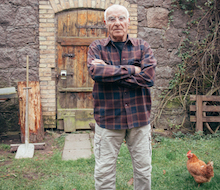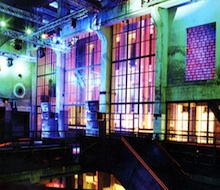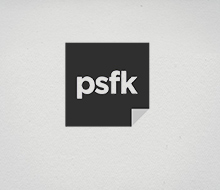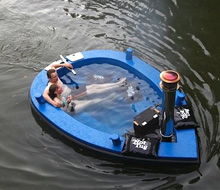For PSFK‘s Future of Retail 2018 report, we sat down with OneMarket President and Westfield Corporation Board Member Don Kingsborough to discuss how OneMarket is transforming a fragmented industry into an integrated one
If the world’s preeminent retailers were in a Fight Club-esque sparring match over the accolade for “biggest retail juggernaut,” Amazon would win without a blink. The real question on every retailer’s mind, though is: How can they start showing Amazon their game face and stop fighting a losing battle?
In comes Westfield to the rescue as the retail tug-of-war referee. This year, the shopping mall corporation created the world’s first retail technology network, called OneMarket, as a way to finally level the playing field. The network unites retailers, brands, venues and partners to facilitate collaboration, encourage data sharing and implement new technologies like natural voice processing, AI and AR at scale.
Not only does it enable retailers to overcome speed-to-market challenges, but it provides customers with the most frictionless shopping experience possible, allowing them to shop at multiple retailers with just one shopping cart—in other words, embodying Amazon-esque convenience in the physical world. The team also developed a live receipt functionality that transforms any post-purchase transaction into a communication device that shoppers can use to talk to customer service in real-time, whether they’re in-store or at home.
We sat down with OneMarket President and Westfield Corporation Board Member Don Kingsborough to discuss how OneMarket is reshaping the way the world shops and creating better experiences for all of retail.
PSFK: Westfield’s newly launched Century City location was developed in order to charm people into shopping on foot again, rather than just online. What do you see as the important trends shaping the future of retail at the moment? How is the industry evolving?
Don: Retailers need to change the way they think about their business. They have to think about it more like Amazon or Apple. The most successful business models have been platforms and networks. Retailers to date have thought about themselves as islands, where you vertically integrate everything and everything is about what’s within the bounds of their physical stores and websites.
They have to think about collaboration from the standpoint of it not just being what someone does inside of their store, but what the consumer does outside of their store. That’s when collaboration will work in your favor. With all the new technologies available today, people can’t think about retail the same way they historically thought about retail. Target, Nordstrom, Macy’s, Home Depot and Walgreens have all developed their own way of doing things. Right now, their biggest competitor is Amazon but at the same time, they’re also enabling Amazon, because the way in which Amazon has constructed its platform by networking all of these retailers means they have essentially taken their consumers.
How can we develop a platform that enables the consumer to shop in one, streamlined way, even though it’ll be across multiple retailers? That’s a way to level the playing field against a very ferocious competitor like Amazon.
After years of seeing Amazon and other internet outlets encroach on traffic and sales, mall operators like Westfield are fighting back. What do you think are the key strategies that retailers and brands should adopt in order to compete with the likes of Amazon, especially when it comes to improving the integration between the web and physical stores?
To be open-minded and open-armed about collaborating with our fiercest competitors. It’s not just retailers that have to do it, but also shopping mall operators. In order for the shopping mall to be successful, the retailers within a mall have to be successful.
To me, the future of retail is about creating memorable experiences that you can’t get simply by going to a website. The more engaging the experience, the more consumers will start to shop more in these physical environments.
The retail space isn’t black and white anymore, where stores can be defined as simply online or brick and mortar. Now that these physical and digital worlds blend together, how should brands be utilizing technology to improve shopping experiences?
Shopping malls and retailers have to stop thinking about getting bigger, and instead think about getting faster. That’s why OneMarket is building a platform that enables retailers and other shopping malls to develop products much faster and adopt new technologies, like natural language, augmented reality and machine learning.
These kinds of things have to be in the toolset of retailers and shopping mall operators, just like they are in the tool sets of many of the large online shopping marketplaces like Amazon. We have to adopt these things, and they have to work both online and in physical stores. We have to know who the customer is and what they’re trying to accomplish because 70% of these people will go online before they ever visit a store or shopping mall.
We have to then treat consumers as if we know what they want, or at least embrace the fact that we’re willing to understand what they want so we can help them and make it seamless. We have to integrate the same toolsets in a physical environment that Amazon has in a digital environment.
Just take identity. Store websites know who you are, what you’ve bought, how long you hover over an area, what you’re most interested in and how many stores do you shop at. We need to find a way to give consumers one basket that checks out, even though they might be shopping at multiple stores.
On that note, how does OneMarket’s retail technology network utilize IoT technology and AI-powered analytics to help transform Westfield’s shopper experiences?
One of our pilots is something called live receipt. It takes a post-purchase transaction and enables that transaction to become the starting point for a communication with a customer on their preferred device with video, photos and questions, all using chatbots and soon natural language. You can just talk to this digital receipt either when you’re in a physical store location or at home on your iPad. It works across retailers. It works no matter which store you’re in. It’s the first real connective tissue that works across retailers and shopping malls, and enables the consumer to do whatever they want when they want.
How are you capturing customer behaviors and activity and then translating that data into valuable insights?
Assuming the consumer opts in, we can take their behavior and give them offers for the stores they shop at and show them where sales are occurring. We can do all of that digitally by knowing who they are when they walk into the shopping mall or retail store. Just like hovering over an item online, we can see exactly what they’re looking at in a window or which stores they’re shopping at, and then figure what they’re most interested in based on these actions.
How are you redesigning the consumer’s point of sale experience?
We are working on simplifying checkout technology. We are also evaluating automating the returns so we can give credit to people instantaneously when they bring the product back. If they don’t want to bring it back to the store, we will be introducing drop-off points nearer to where they live that are more convenient.
How are you experimenting with a mix of automation and expedited services to remove friction from key transactions within the purchase path?
Ultimately it’s about integrating things into the everyday life of a consumer, not just when it comes to shopping, but exercise, wellness, health, food.It’s about augmenting how people live their daily lives. Whether they’re shopping for a dress, getting their makeup done or buying a new pair of shoes. It all has to be there in their purchase path. For the consumer today, time is the most valuable thing they have. The more of those things that you can accommodate, the more likely they are to come back again.
What’s on the horizon for One Market in 2018 and beyond?
What we’re doing is essentially creating an underlying network and set of platforms that enables retailers and shopping malls to go from slow to fast, instead of from big to bigger. We are developing technologies that allow them to adopt solutions much more economically, and give them the opportunity to start taking physical spaces and turning them it into an advantage.and winning against their competitors for the first time.
For more information on how companies can transform their physical stores into experience centers that extend their supply chain and digital commerce platforms, check out PSFK’s Future of Retail 2018.



















































































